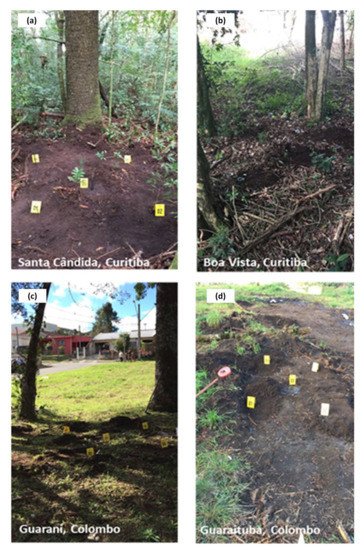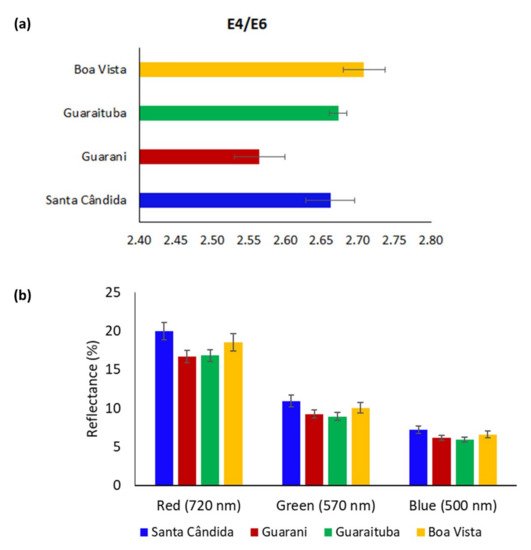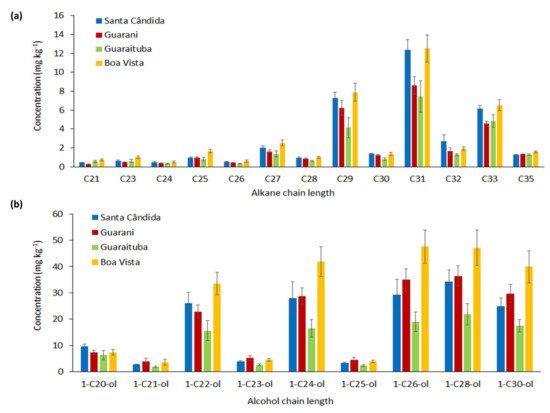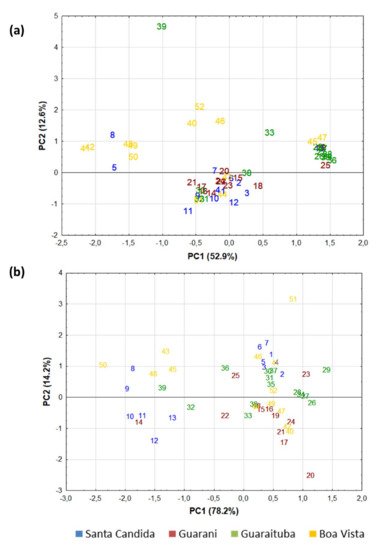You're using an outdated browser. Please upgrade to a modern browser for the best experience.
Please note this is an old version of this entry, which may differ significantly from the current revision.
Subjects:
Soil Science
Most cases involving soil in criminal investigations in Brazil have focused on the chemical and mineralogical analyses of soil fractions without including the organic matter. The organic fraction contains plant-wax markers which may be useful to “fingerprint” forensic soils due to their chemical diversity, relative longevity and resistant nature.
- forensic
- gas chromatography
- n-alkanes
- alcohols
1. Introduction
In forensic science, soil is an important form of trace evidence and can be used to test for potential links between soil on a questioned item and a potential source location. Since traces of soil can readily become trapped on the underside of footwear and on vehicle tires, soil has long been considered to be a potential source of forensic information [1,2,3,4,5,6]. Provided that a well-tested and robust method (with chemical, physical, mineralogical and organic data) for the characterisation of the samples is available and used appropriately, a potential link can be tested and established between a suspect and a crime scene [3,4].
Inorganic soil analyses have been successfully used in forensic investigations [3,4,7,8,9,10,11], and organic approaches have less frequently been employed. Many soils have less than 5% (w/w) of organic matter content, particularly tropical and subtropical soils, and this has expressive effects on the biological, chemical and physical characteristics of the soil, even if it is present at reduced contents. Furthermore, this material can be used successfully in forensic studies, as organic matter is an inherent part of the soil, that is, for a given material to be considered as soil, it must have a minimum level of organic material, in addition to containing the inorganic mineral fractions (sand, silt and clay) in different proportions. As the concentration of organic matter varies with the soil concentration, dilutions of the organic matter content depend on the amount of soil sampled at the crime scene, such as the amount found on the sole of shoes and on the vehicle tires [3,4,12,13].
Traditional forensic approaches in Brazil have focused on the determination of the total elemental content and the physical fractionation of the soil [14]. In an alternative forensic approach, the composition of soil organic matter is determined by pyrolysis–gas chromatography/mass spectrometry (Py–GC/MS) [15]. Py–GC/MS analyses allow a qualitative investigation of the nature of organic materials and are efficient in identifying different compounds at the molecular level [16]. Soil organic biomarkers have received limited attention in forensic soil science, with only a few studies worldwide [17,18,19,20]. The relative abundance of organic compounds can vary considerably between soil samples only a short distance apart [13,21]. In most soils, especially in the topsoil, the organic compounds which have originated from the surface wax of plants are abundant. These compounds enter into the soil as fallen plant leaves and plant litter such as seeds, flowers and stems. Since plant roots have low concentrations of plant-wax compounds, they generally make a small contribution to the total content of these compounds in soils [4,18]. The most common and widely studied wax-marker compound class is the hydrocarbons, including n-alkanes, and the free and esterified long-chain fatty alcohols (high molecular-weight, straight-chain primary alcohols, derived from natural fats and oils) and fatty acids (carboxylic acids with a long aliphatic chain, containing a hydrocarbon chain and a terminal carboxyl group) [17,22,23,24] can also be used.
Forensic studies using plant-wax compounds have been tested mainly under temperate conditions, over a wide range of both rural and urban areas [17,20]. Under tropical and subtropical conditions, the potential of the use of plant-wax biomarkers in a forensic context is still unknown. The soil has a unique and ubiquitous nature given its physical, chemical, biological and mineralogical characteristics, which allow it to be differentiated between the most varied environments. The uniqueness of the soil in regard to its characteristics makes it a powerful source of information in forensic investigations, because, due to its variability, it is possible to discriminate and associate it with a specific individual or object related to a crime scene. In tropical and subtropical conditions, it is observed that inorganic mineral fractions are more frequently used to investigate traces of soil sampled at crime scenes, possibly due to several factors, such as the heterogeneous nature of soils under different climatic conditions which leads, for example, to the wide variations of the organic matter decomposition rates in relation to soils from temperate regions.
2. Soil Sites and Sampling
Two areas from the Curitiba municipality and two areas from the Colombo municipality, Paraná State, in the South of Brazil, were selected: the Santa Cândida and Boa Vista neighbourhoods of Curitiba and the Guarani and Guaraituba neighbourhoods of Colombo, located in the Metropolitan Region of Curitiba (Figure 1 and Figure 2). All soils were classified as inceptisol according to U.S. Soil Taxonomy [34] and as cambissolo háplico according to the Brazilian Soil Classification System [35].

Figure 1. (a) Schematic figure of Brazil highlighting the Paraná State (PR) and the Curitiba Metropolitan Region (CMR); (b) two selected municipalities within the CMR; and (c) linear distance between the sampled sites (site 1—Santa Cândida neighbourhood; site 2—Boa Vista neighbourhood, Guarani neighbourhood, Guaraituba neighbourhood).

Figure 2. Sampling locations within Curitiba and Colombo municipalities, State of Paraná, Brazil. Photographs located in four separate urban areas: Santa Cândida—Curitiba (a); Boa Vista—Curitiba (b); Guarani—Colombo (c); Guaraituba—Colombo (d). Source: modified from (Testoni et al., 2019).
3. Soil Colour Analysis
The samples collected in the Guarani neighbourhood (Table 1) presented the lowest values for the E4/E6 ratio (Figure 3a). The E4/E6 ratio is related to the condensation degree of the aromaticity or aliphaticity and the molecular weight of organic compounds [39,42,43]. Higher E4/E6 ratios (Boa Vista neighbourhood) are generally associated with more aliphatic and low-molecular-weight structures [44], with branched and straight-chain carbons [45,46]. The greater presence of vegetation with aliphatic groups (less humified) in Boa Vista could also be observed in the greater reflectance at 725–720 nm (red region) (Figure 3b), typical of long aliphatic chains with C–C and C–H bonds [45]. The RGB reflectance of the visible spectrum (500 to 720 nm) may be attributed to less aromatic chemical structures. These relationships obtained through colour spectroscopy and the qualitative aspects of the organic matter may be related to the nature of the residue of plants present in the soil [44,47].

Figure 3. Average of soil-colour parameters for the four sites: (a) E4/E6 ratio (absorbance at 465/absorbance at 665 nm) and (b) RGB (red, green, blue) data obtained from the reflectance values of the visible spectra at 720, 570 and 500 nm wavelengths, respectively (Santa Cândida—n = 13 samples (Table 1) × 3 replicates = 39; Guarani—n = 12 samples × 3 replicates = 36; Guaraituba—n = 14 samples × 3 replicates = 42; Boa Vista—n = 13 samples × 3 replicates = 39).
At all the sites there was a predominance of odd long-chain alkanes (C29, C31 and C33); on the other hand, the values of C35 were low (Figure 4a). The hydrocarbons, including n-alkanes, are the most common and widely studied wax compounds [22,26,48]. The provenance of these compounds is mainly from the wax of the vegetation that enters into the soil as fallen leaves and other plant litter such as seeds, flowers and stems [12]. The n-alkanes, with odd-numbered carbon chains, are the predominant markers found in cuticular wax, especially the C27, C29, C31 and C33 alkanes [24,27,47], with C29 and C31 being the dominant compounds (Figure 4a).

Figure 4. Mean (± standard deviation) n-alkane (a) and alcohol (b) concentrations for the four sites (Santa Cândida—n = 13 samples (Table 1) × 3 replicates = 39; Guarani—n = 12 samples × 3 replicates = 36; Guaraituba—n = 14 samples × 3 replicates = 42; Boa Vista—n = 13 samples × 3 replicates = 39).
C27, C29 and C31 alkane content is commonly found in the same corresponding plants, which explains the greater presence of these long-chain waxes in all the soils from the sites studied (Figure 4a). However, the compound concentrations in the plant may vary according to the photosynthetic pathways [49]. In some studies, it has been postulated that C31 represents grass input, while C27 and C29 represent input from trees and shrubs [17,22,23,24]. The input of different plant species at various stages of decomposition as a result of more intensive human influence is reflected in the higher concentrations of these long-chain alkanes at the Boa Vista site (Figure 4a). The lower concentrations of n-alkanes at the Guarani site (Figure 4a) may be associated with the low E4/E6 ratios (Figure 3a), which indicate the small input of more condensed chemical structures.
The consequent soil wax concentrations were also a result of the climatic conditions, reflecting the faster biosynthesis of these compounds under tropical and subtropical conditions [50] than under temperate conditions. The biodegradation of n-alkanes, for example, occurs at mesophilic temperatures [34]. Higher temperatures and increased rainfall were commonly found in Brazil, compared to the studies carried out in a temperate climate such as in the UK [28,33].
All the variables obtained in the study (spectral colour, alkanes and alcohols) were explored using principal component analysis (PCA) (Figure 5). The cumulative variance of the principal components one and two (PC1 and PC2) was high. The samples from the Guaraituba neighbourhoods were grouped well in the PCA (Figure 5a), with a related Bray–Curtis clustering of similarity (6a) based on n-alkanes and fatty alcohols. The use of plant-wax markers in discriminating between soils/sediments from different plant communities has been clearly demonstrated on UK soils under temperate conditions [4,27,28].

Figure 5. Principal Component Analysis (PCA) of the soil samples analysed based on n-alkanes and fatty alcohols (a) and spectral colour data (b).
4. Conclusions
Both the soil colour and the composition of the plant-wax markers were highly variable at medium (metres) and short distances (centimetres). Under the environmental conditions of the present study (urban area with a subtropical climate), the composition of the wax markers was different in samples collected side-by-side (for example, the sole of a suspect’s boot). The composition of the biomarkers was very sensitive to local variations under subtropical conditions and in areas under intense urban use. Under these conditions, biomarkers may be used in real crime scenes on a centimetre scale of variation or when using average values from a large number of soil samples. The analysis of alkanes was more discriminating compared with alcohols. Consideration should be given to the spatial scale of the variability of the methods used in any investigation, as it is important in the evaluation of potential linkages with a particular location, such as at a crime scene. This is why two or more analytical methods are often adopted in a case to avoid potential false exclusions or false associations.
This entry is adapted from the peer-reviewed paper 10.3390/forensicsci2010005
This entry is offline, you can click here to edit this entry!
